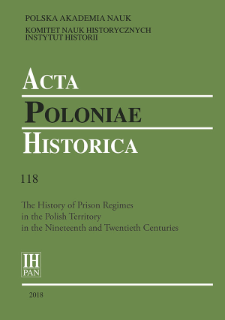- Wyszukaj w całym Repozytorium
- Piśmiennictwo i mapy
- Archeologia
- Baza Młynów
- Nauki przyrodnicze
Wyszukiwanie zaawansowane
Wyszukiwanie zaawansowane
Wyszukiwanie zaawansowane
Wyszukiwanie zaawansowane
Wyszukiwanie zaawansowane

Obiekt
Tytuł: Double-Track System in Polish Criminal Law : Political and Criminal Assumptions, History, Contemporary References
Inny tytuł:
The History of Prison Regimes in the Polish Territory in the Nineteeth and Twentieth Centuries ; Acta Poloniae Historica T. 118 (2018)
Współtwórca:
Instytut Historii Polskiej Akademii Nauk ; Komitet Nauk Historycznych Polskiej Akademii Nauk ; Cieszyńska-Klimek, Magda : Tł.
Wydawca:
Instytut Historii im. Tadeusza Manteuffla Polskiej Akademii Nauk
Miejsce wydania:
Opis:
Typ obiektu:
Abstrakt:
The authors of the penal code of 1932 modelled their reaction measures on the best contemporary standards. The system of criminal response was based on a double-track model, in German called zwei Spuren, in Italian – doppio binario, in which, along with penalties, there were also preventive measures. This system grew out of certain political and criminal assumptions of the sociological school, expressed most fully in the works of Franz von Liszt. Return in contemporary law, to the wide use of preventive measures, post and pre-penal, forces us to return to the sources and to critically examine the assumptions of the indicated approach, including the idea of an incorrigible criminal who should be isolated, not in relation to what he did, but because of who he is. Tracing the history of regulations, in particular their practical application should be a lesson for modern lawmakers.
Bibliografia:
Batawia Stanisław, ‘Niepoprawni przestępcy w świetle 150 wyroków z art. 84 k.k.’, Archiwum Kryminologiczne, ii, 3–4 (1937).
Drenkhahn Kirstin, ‘Secure preventive detention in Germany: Incapacitation or treatment intervention’, Behavioral Sciences & the Law, xxxi (2013), 312–27.
Górny Jerzy, Elementy indywidualizacji i humanizacji karania w rozwoju penitencjarystyki (Warszawa, 1996).
Kwieciński Adam, Lecznicze środki zabezpieczające w polskim prawie karnym i praktyka ich wykonywania (Warszawa, 2009).
Pelissero Marco, The doppio binario in Italian criminal law, https://studylib.net/ doc/10742443/the-doppio-binario-in-italian-criminal-law--marco-pelissero [Accessed: 15 Jan. 2019].
Rabinowicz Leon, Podstawy nauki o więziennictwie (Warszawa, 1933).
Simple Janet, Bentham’s Prison: A Study of the Panopticon Penitentiary (Oxford, 1993).
Wąsowicz Marek, Nurt socjologiczny w polskiej myśli prawnokarnej (Warszawa, 1989).
Wetzell Richard F., Inventing the Criminal. A History of German Criminology, 1880–1945 (Chapel Hill and London, 2000).
Zalewski Wojciech, ‘Therapeutic and Legislative Approaches to Sex Offenders in Poland’, Monatsschrift für Kriminologie und Strafrechtsreform, xcvii, 1 (2014), Gunda Wößner (ed.), Developing Sexual Offender Laws and Treatment in Europe, 48–56.
Zalewski Wojciech, Przestępca ‘niepoprawny’ – jako problem polityki kryminalnej (Gdańsk, 2010).
Czasopismo/Seria/cykl:
Tom:
Strona pocz.:
Strona końc.:
Szczegółowy typ zasobu:
Format:
Identyfikator zasobu:
oai:rcin.org.pl:71877 ; 0001-6829 ; 2450-8462 ; 10.12775/APH.2018.118.02
Źródło:
IH PAN, sygn. A.295/118 Podr. ; IH PAN, sygn. A.296/118 ; kliknij tutaj, żeby przejść
Język:
Prawa:
Licencja Creative Commons Uznanie autorstwa-Bez utworów zależnych 4.0
Zasady wykorzystania:
Zasób chroniony prawem autorskim. [CC BY-ND 4.0 Międzynarodowe] Korzystanie dozwolone zgodnie z licencją Creative Commons Uznanie autorstwa-Bez utworów zależnych 4.0, której pełne postanowienia dostępne są pod adresem: ; -
Digitalizacja:
Instytut Historii Polskiej Akademii Nauk
Lokalizacja oryginału:
Biblioteka Instytutu Historii PAN
Dofinansowane ze środków:
Narodowy Program Rozwoju Humanistyki
Dostęp:
Kolekcje, do których przypisany jest obiekt:
- Repozytorium Cyfrowe Instytutów Naukowych > Kolekcje Partnerów > Instytut Historii PAN > Czasopisma
- Repozytorium Cyfrowe Instytutów Naukowych > Kolekcje Partnerów > Instytut Historii PAN > Wydawnictwa Instytutu
- Repozytorium Cyfrowe Instytutów Naukowych > Kolekcje Partnerów > Instytut Historii PAN > Wydawnictwa Instytutu > Czasopisma
- Repozytorium Cyfrowe Instytutów Naukowych > Kolekcje Partnerów > Instytut Historii PAN > Wydawnictwa Instytutu > Czasopisma > Acta Poloniae Historica
- Repozytorium Cyfrowe Instytutów Naukowych > Piśmiennictwo > Czasopisma/Artykuły
Data ostatniej modyfikacji:
22 wrz 2023
Data dodania obiektu:
30 maj 2019
Liczba pobrań / odtworzeń:
478
Wszystkie dostępne wersje tego obiektu:
https://rcin.org.pl./publication/93535
Wyświetl opis w formacie RDF:
Wyświetl opis w formacie RDFa:
Wyświetl opis w formacie OAI-PMH:
Obiekty Podobne
Kudlak, Grzegorz Zimny, Mateusz
Sadowski, Marcin
Hass, Ludwik (1918–2008)
Gałęziowska, Małgorzata
Tripplin, Teodor (1813–1881)

 INSTYTUT ARCHEOLOGII I ETNOLOGII POLSKIEJ AKADEMII NAUK
INSTYTUT ARCHEOLOGII I ETNOLOGII POLSKIEJ AKADEMII NAUK
 INSTYTUT BADAŃ LITERACKICH POLSKIEJ AKADEMII NAUK
INSTYTUT BADAŃ LITERACKICH POLSKIEJ AKADEMII NAUK
 INSTYTUT BADAWCZY LEŚNICTWA
INSTYTUT BADAWCZY LEŚNICTWA
 INSTYTUT BIOLOGII DOŚWIADCZALNEJ IM. MARCELEGO NENCKIEGO POLSKIEJ AKADEMII NAUK
INSTYTUT BIOLOGII DOŚWIADCZALNEJ IM. MARCELEGO NENCKIEGO POLSKIEJ AKADEMII NAUK
 INSTYTUT BIOLOGII SSAKÓW POLSKIEJ AKADEMII NAUK
INSTYTUT BIOLOGII SSAKÓW POLSKIEJ AKADEMII NAUK
 INSTYTUT CHEMII FIZYCZNEJ PAN
INSTYTUT CHEMII FIZYCZNEJ PAN
 INSTYTUT CHEMII ORGANICZNEJ PAN
INSTYTUT CHEMII ORGANICZNEJ PAN
 INSTYTUT FILOZOFII I SOCJOLOGII PAN
INSTYTUT FILOZOFII I SOCJOLOGII PAN
 INSTYTUT GEOGRAFII I PRZESTRZENNEGO ZAGOSPODAROWANIA PAN
INSTYTUT GEOGRAFII I PRZESTRZENNEGO ZAGOSPODAROWANIA PAN
 INSTYTUT HISTORII im. TADEUSZA MANTEUFFLA POLSKIEJ AKADEMII NAUK
INSTYTUT HISTORII im. TADEUSZA MANTEUFFLA POLSKIEJ AKADEMII NAUK
 INSTYTUT JĘZYKA POLSKIEGO POLSKIEJ AKADEMII NAUK
INSTYTUT JĘZYKA POLSKIEGO POLSKIEJ AKADEMII NAUK
 INSTYTUT MATEMATYCZNY PAN
INSTYTUT MATEMATYCZNY PAN
 INSTYTUT MEDYCYNY DOŚWIADCZALNEJ I KLINICZNEJ IM.MIROSŁAWA MOSSAKOWSKIEGO POLSKIEJ AKADEMII NAUK
INSTYTUT MEDYCYNY DOŚWIADCZALNEJ I KLINICZNEJ IM.MIROSŁAWA MOSSAKOWSKIEGO POLSKIEJ AKADEMII NAUK
 INSTYTUT PODSTAWOWYCH PROBLEMÓW TECHNIKI PAN
INSTYTUT PODSTAWOWYCH PROBLEMÓW TECHNIKI PAN
 INSTYTUT SLAWISTYKI PAN
INSTYTUT SLAWISTYKI PAN
 SIEĆ BADAWCZA ŁUKASIEWICZ - INSTYTUT TECHNOLOGII MATERIAŁÓW ELEKTRONICZNYCH
SIEĆ BADAWCZA ŁUKASIEWICZ - INSTYTUT TECHNOLOGII MATERIAŁÓW ELEKTRONICZNYCH
 MUZEUM I INSTYTUT ZOOLOGII POLSKIEJ AKADEMII NAUK
MUZEUM I INSTYTUT ZOOLOGII POLSKIEJ AKADEMII NAUK
 INSTYTUT BADAŃ SYSTEMOWYCH PAN
INSTYTUT BADAŃ SYSTEMOWYCH PAN
 INSTYTUT BOTANIKI IM. WŁADYSŁAWA SZAFERA POLSKIEJ AKADEMII NAUK
INSTYTUT BOTANIKI IM. WŁADYSŁAWA SZAFERA POLSKIEJ AKADEMII NAUK




































